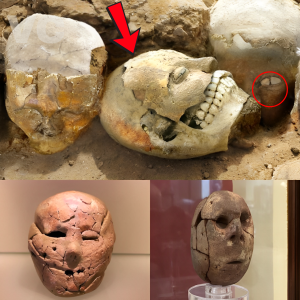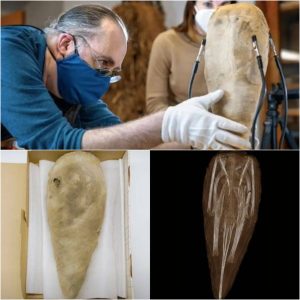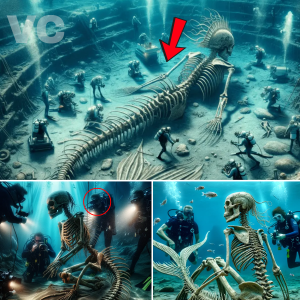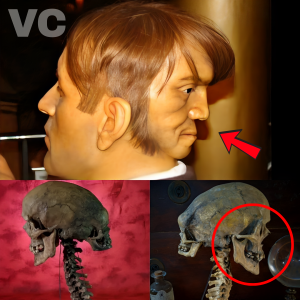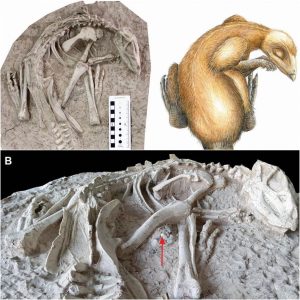The last person to live full-time in the Boundary Waters was Dorothy Molter, who sold her famous root beer — brewed with the cold, clean water of the lake — from her cabin on Isles of Pines, in Knife Lake. Though no permanent structures were allowed in the wilderness after the passing of the Boundary Waters Canoe Area Wilderness Act in 1978, Molter’s cabin was not removed at that time. Instead, it was grandfathered in and became a destination — and a novelty — for paddlers until she passed away in 1986.
Coincidentally, Knife Lake, which was host to the last human settlement in the Boundary Waters, may have also been the site of the some of the first human activity in the area.
In the indistinct, black and gray siltstone rock around Knife Lake, archeologists have found artifacts and fragments that suggest humans have been in the area for much longer than previously thought. The siltstone here served as an important resource. It was chipped and knapped to make essential tools for a hunter gatherer society to survive in the harsh world that emerged from under the retreating glaciers.

The forests surrounding Knife Lake were devastated by the July 4, 1999 blow down. In the following years, prescribed burns exposed bedrock and soil that had been covered by trees and vegetation for centuries.
This clearing provided a chance for archeologists to build off the discovery of agate points and other artifacts made by Canadian archeologist John Nelson on the Canadian (North Arm) of Knife Lake. Prior to Nelson’s finding, most archeologist believed that, because the land had been so devastated by the glaciers and so inhospitable to life, people would not have traveled, much less inhabited the area for thousands of years after the glaciers receded. Nelson’s discovery changed this and most now agree that people moved into the area much sooner, within hundreds of years after the glacier melted.
Was there evidence of similar human activity on the United States side?

In 2009, the Superior National Forest invited Dr. Mark Muñiz, a professor at St. Cloud State University to survey known archeological sites. Over the next five years, he returned to conduct more intensive surveys and excavations. Because the area in which Muñiz worked is in the Boundary Waters, a federally designated Wilderness Area, his team took special environmental and cultural precautions. This included consulting with the Ojibwe and Dakota, and closely coordinating with Lee Johnson, the U.S. Forest Service Archeologist.
Muñiz and his team staked out areas based on the presence of stone flakes and exposed artifacts found on the surface, as well as a sufficient layer of sediment that would allow them to separate and date artifacts. They found numerous sharp-edge objects, tools that had been fashioned from the siltstone to hunt and fish. In their excavations, they found more than was originally anticipated, which led to more questions.
“A problem faced by any hunter and gatherer society is – where do you get the rock to make your tools, to make your weapons?” says Muñiz. “Because of this, we know that quarries such as these played an important role. A well-used quarry, such as found in Knife Lake would have been an “anchor” for people to get resources. As an important resource for the region, the question is: would have been a destination for people to travel to, or a center for habitation?”

By dating the sediment that encapsulated the artifact — a technique called optically stimulated luminescence (OSL) — Muñiz’s research suggests that people were using the quarries at Knife Lake as early as 13,000 years ago. This dating supports previous findings that people arrived in the area much earlier than previously thought, and were probably living along the edge of the glacial margin, following it northwards as the ice receded.
That world was, of course, much different than it is today. Not only did herds of caribou, and maybe megafauna, roam the area around Knife Lake, but the physical geography was much different as well. The lakes and waterways have changed so much since then that it’s impossible to know exactly how people accessed the area. Did they use boats, or some sort of watercraft? How was knowledge of the quarries passed down? Were tools made from Knife Lake siltstone traded?
In search of clues to these answers, Muñiz has contacted archeologists and museums in the Upper Midwest to see if artifacts from the Knife Lake quarries have shown up in other areas, which would suggest trade or travel. Other questions, like did they use a type of watercraft to reach the quarries, will probably never be answered.
The finding unearthed at Knife Lake are fragments of a lost story. The small chips and knapped stone contain mysteries and wonder. They are part of a wilderness that was vital for people 13,000 years ago, and is vital for us today.
